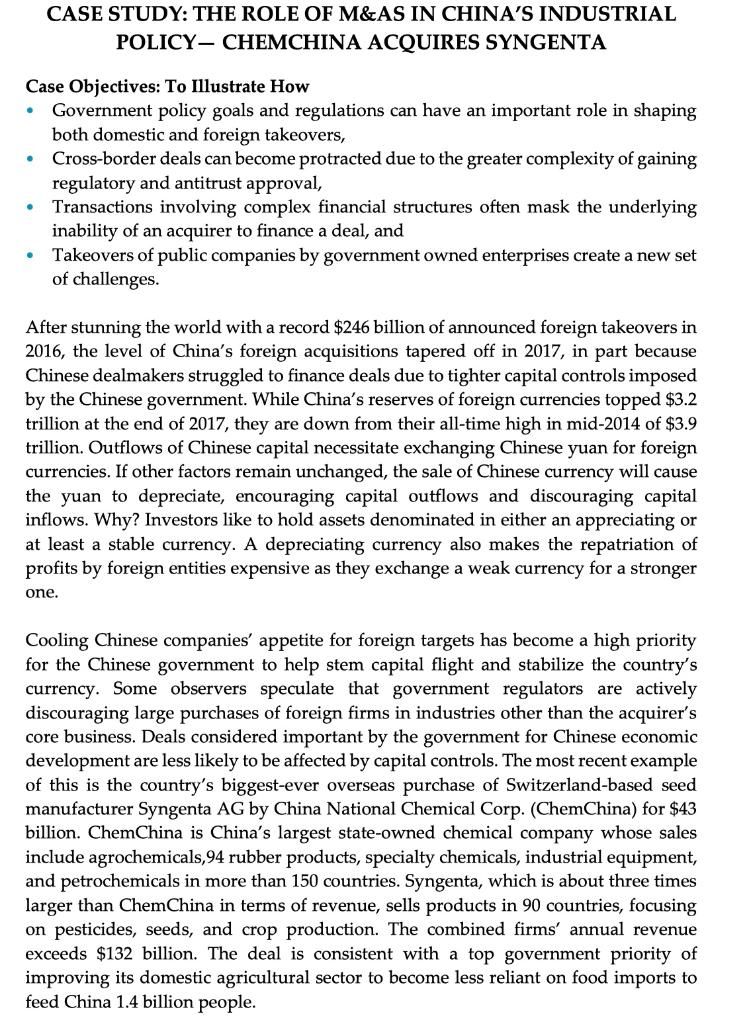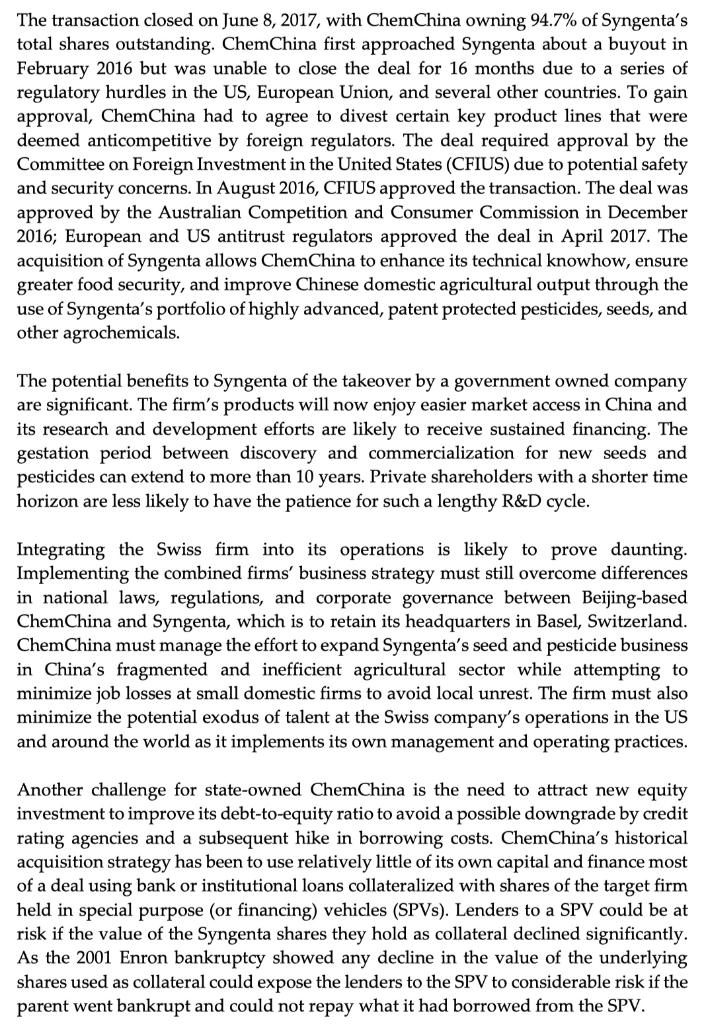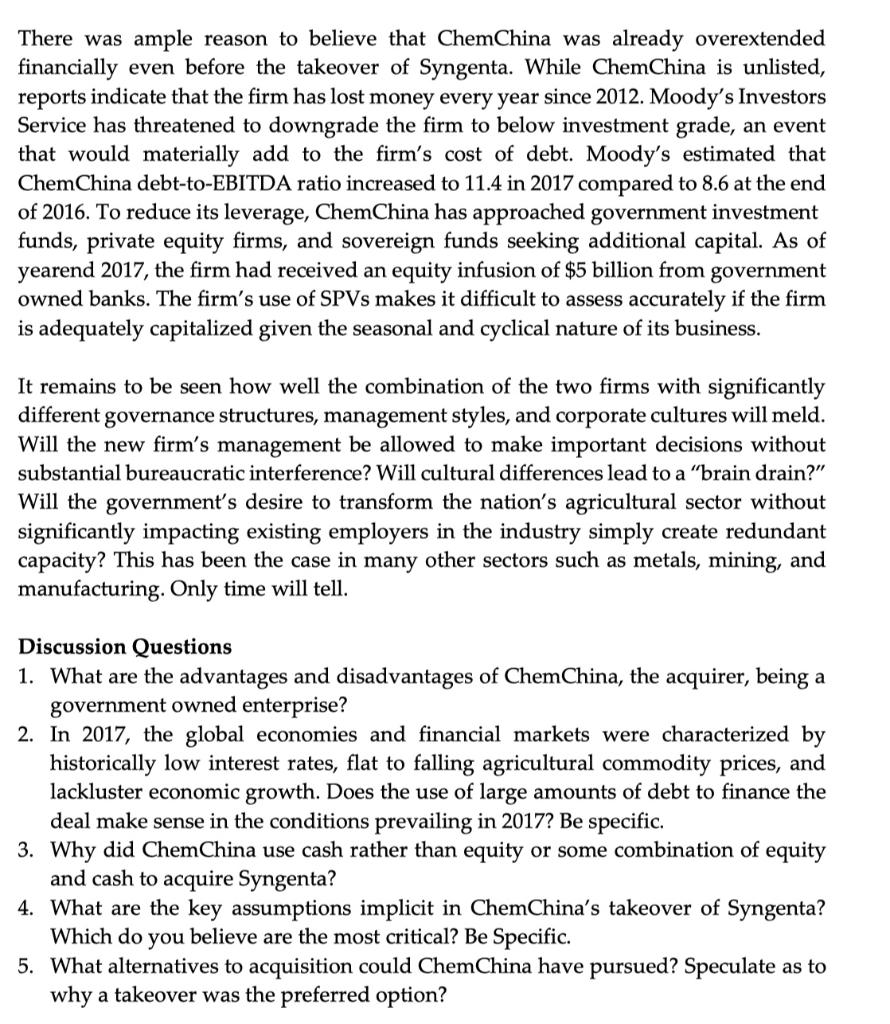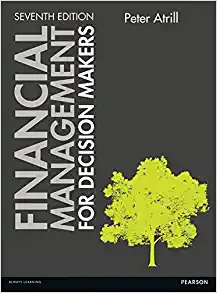


CASE STUDY: THE ROLE OF M&AS IN CHINA'S INDUSTRIAL POLICY- CHEMCHINA ACQUIRES SYNGENTA Case Objectives: To Illustrate How Government policy goals and regulations can have an important role in shaping both domestic and foreign takeovers, Cross-border deals can become protracted due to the greater complexity of gaining regulatory and antitrust approval, Transactions involving complex financial structures often mask the underlying inability of an acquirer to finance a deal, and Takeovers of public companies by government owned enterprises create a new set of challenges. . . After stunning the world with a record $246 billion of announced foreign takeovers in 2016, the level of China's foreign acquisitions tapered off in 2017, in part because Chinese dealmakers struggled to finance deals due to tighter capital controls imposed by the Chinese government. While China's reserves of foreign currencies topped $3.2 trillion at the end of 2017, they are down from their all-time high in mid-2014 of $3.9 trillion. Outflows of Chinese capital necessitate exchanging Chinese yuan for foreign currencies. If other factors remain unchanged, the sale of Chinese currency will cause the yuan to depreciate, encouraging capital outflows and discouraging capital inflows. Why? Investors like to hold assets denominated in either an appreciating or at least a stable currency. A depreciating currency also makes the repatriation of profits by foreign entities expensive as they exchange a weak currency for a stronger one. Cooling Chinese companies' appetite for foreign targets has become a high priority for the Chinese government to help stem capital flight and stabilize the country's currency. Some observers speculate that government regulators are actively discouraging large purchases of foreign firms in industries other than the acquirer's core business. Deals considered important by the government for Chinese economic development are less likely to be affected by capital controls. The most recent example of this is the country's biggest-ever overseas purchase of Switzerland-based seed manufacturer Syngenta AG by China National Chemical Corp. (ChemChina) for $43 billion. ChemChina is China's largest state-owned chemical company whose sales include agrochemicals,94 rubber products, specialty chemicals, industrial equipment, and petrochemicals in more than 150 countries. Syngenta, which is about three times larger than ChemChina in terms of revenue, sells products in 90 countries, focusing on pesticides, seeds, and crop production. The combined firms' annual revenue exceeds $132 billion. The deal is consistent with a top government priority of improving its domestic agricultural sector to become less reliant on food imports to feed China 1.4 billion people. The transaction closed on June 8, 2017, with ChemChina owning 94.7% of Syngenta's total shares outstanding. ChemChina first approached Syngenta about a buyout in February 2016 but was unable to close the deal for 16 months due to a series of regulatory hurdles in the US, European Union, and several other countries. To gain approval, ChemChina had to agree to divest certain key product lines that were deemed anticompetitive by foreign regulators. The deal required approval by the Committee on Foreign Investment in the United States (CFIUS) due to potential safety and security concerns. In August 2016, CFIUS approved the transaction. The deal was approved by the Australian Competition and Consumer Commission in December 2016; European and US antitrust regulators approved the deal in April 2017. The acquisition of Syngenta allows ChemChina to enhance its technical knowhow, ensure greater food security, and improve Chinese domestic agricultural output through the use of Syngenta's portfolio of highly advanced, patent protected pesticides, seeds, and other agrochemicals. The potential benefits to Syngenta of the takeover by a government owned company are significant. The firm's products will now enjoy easier market access in China and its research and development efforts are likely to receive sustained financing. The gestation period between discovery and commercialization for new seeds and pesticides can extend to more than 10 years. Private shareholders with a shorter time horizon are less likely to have the patience for such a lengthy R&D cycle. Integrating the Swiss firm into its operations is likely to prove daunting. Implementing the combined firms' business strategy must still overcome differences in national laws, regulations, and corporate governance between Beijing-based ChemChina and Syngenta, which is to retain its headquarters in Basel, Switzerland. ChemChina must manage the effort to expand Syngenta's seed and pesticide business in China's fragmented and inefficient agricultural sector while attempting to minimize job losses at small domestic firms to avoid local unrest. The firm must also minimize the potential exodus of talent at the Swiss company's operations in the US and around the world as it implements its own management and operating practices. Another challenge for state-owned ChemChina is the need to attract new equity investment to improve its debt-to-equity ratio to avoid a possible downgrade by credit rating agencies and a subsequent hike in borrowing costs. ChemChina's historical acquisition strategy has been to use relatively little of its own capital and finance most of a deal using bank or institutional loans collateralized with shares of the target firm held in special purpose (or financing) vehicles (SPVs). Lenders to a SPV could be at risk if the value of the Syngenta shares they hold as collateral declined significantly. As the 2001 Enron bankruptcy showed any decline in the value of the underlying shares used as collateral could expose the lenders to the SPV to considerable risk if the parent went bankrupt and could not repay what it had borrowed from the SPV. There was ample reason to believe that ChemChina was already overextended financially even before the takeover of Syngenta. While ChemChina is unlisted, reports indicate that the firm has lost money every year since 2012. Moody's Investors Service has threatened to downgrade the firm to below investment grade, an event that would materially add to the firm's cost of debt. Moody's estimated that ChemChina debt-to-EBITDA ratio increased to 11.4 in 2017 compared to 8.6 at the end of 2016. To reduce its leverage, ChemChina has approached government investment funds, private equity firms, and sovereign funds seeking additional capital. As of yearend 2017, the firm had received an equity infusion of $5 billion from government owned banks. The firm's use of SPVs makes it difficult to assess accurately if the firm is adequately capitalized given the seasonal and cyclical nature of its business. It remains to be seen how well the combination of the two firms with significantly different governance structures, management styles, and corporate cultures will meld. Will the new firm's management be allowed to make important decisions without substantial bureaucratic interference? Will cultural differences lead to a "brain drain?" Will the government's desire to transform the nation's agricultural sector without significantly impacting existing employers in the industry simply create redundant capacity? This has been the case in many other sectors such as metals, mining, and manufacturing. Only time will tell. Discussion Questions 1. What are the advantages and disadvantages of ChemChina, the acquirer, being a government owned enterprise? 2. In 2017, the global economies and financial markets were characterized by historically low interest rates, flat to falling agricultural commodity prices, and lackluster economic growth. Does the use of large amounts of debt to finance the deal make sense in the conditions prevailing in 2017? Be specific. 3. Why did ChemChina use cash rather than equity or some combination of equity and cash to acquire Syngenta? 4. What are the key assumptions implicit in ChemChina's takeover of Syngenta? Which do you believe are the most critical? Be Specific. 5. What alternatives to acquisition could ChemChina have pursued? Speculate as to why a takeover was the preferred option









